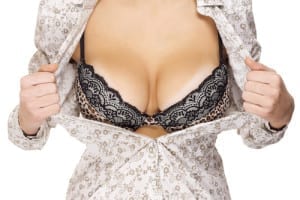The Most Common Myths About Breast Augmentation, Busted!
Posted April 04, 2014 in Breast Augmentation
 Even though breast augmentation is one of the most well-known and well-researched cosmetic procedures, many people still believe a few common myths about breast augmentation. This post will separate fact from fiction and, hopefully, put your mind at ease if you are hesitant about the procedure.
Even though breast augmentation is one of the most well-known and well-researched cosmetic procedures, many people still believe a few common myths about breast augmentation. This post will separate fact from fiction and, hopefully, put your mind at ease if you are hesitant about the procedure.
Myth 1: Breast implants rupture easily.
Since breast implants consist of a soft outer shell that is filled with either saline or silicone gel, it makes logical sense that a certain extent of pressure would cause them to rupture. Although rupture is possible, statistics have shown that it has only occurred in 7 percent of saline implants and 10 percent of silicone implants within the last five years.
One plastic surgeon from Orange County put both saline and silicone implants to the test by running over them with his BMW. The saline implant burst, but the silicone gel implant withstood the weight of the car. All breast implant manufacturers in the United States now sell more form-stable implants (like the so called “gummy-bear” implants) that have an even lower rate of rupture than previous versions due to their increased thickness.
The popular television show Myth Busters further tested this myth to determine whether breast implants would burst if placed at a high altitude or under low air pressure. When placed in a hypobaric chamber, the implants expanded at 35,000 feet, which is an altitude too high for a human to live. A Duke University study concluded that extreme atmospheric conditions such as these would be lethal long before they would affect the implants.
Myth 2: Breast implants look fake.
The validity of this statement is subjective. What one person considers to be “fake,” another might consider voluptuous and attractive. Most reputable board-certified plastic surgeons strive to provide their patients with the most natural-looking results possible when it comes to breast augmentation. When a patient desires larger implants for prominent cleavage and a less natural-looking appearance, Dr. Koch will first make sure that the patient’s chest wall width, natural breast size, and skin elasticity will work to provide the desired outcome safely.
Breast implants can definitely look “fake” when a surgeon does not follow these precautions and the implants fall to the side to create a gap between the breasts, or they bulge out beneath the breasts as a result. These complications are risks with breast augmentation, but they are far less likely to occur at the hands of a skilled breast surgeon. Because there are so many options available with regard to implant size, shape, texture, and placement, Dr. Koch can provide a customized result that will safely and effectively match each patient’s definition of beauty.
Myth 3: Scars are obvious.
Any time incisions are made on the body, scarring will result. While one cannot have invasive surgery without scars, a skilled surgeon can place incisions in areas that are virtually undetectable. Common incision locations for breast augmentation are either beneath the breast along the crease or around the areola. Scars beneath the breasts are easily hidden beneath swimwear and underwear; the areolar scar follows the natural line of the areola so that over time scars will be difficult to detect.
If the patient desires no scars on the breasts, there are other techniques available such as transumbilical breast augmentation (TUBA) which involves an incision in the navel. An unfilled saline implant is inserted through the navel where it is tunneled beneath the skin to the breast. The transaxillary incision will also leave no scars on the breasts as the implant is inserted through an incision in the armpit.
If you are interested in breast augmentation in the Williamsville, NY area, board-certified plastic surgeon Dr. Koch has the knowledge and expertise to provide the results you desire. To schedule a consultation, please call (716) 631-1220 today, or fill out our online contact form for more information.